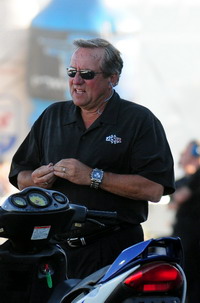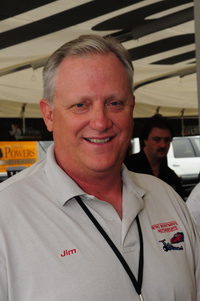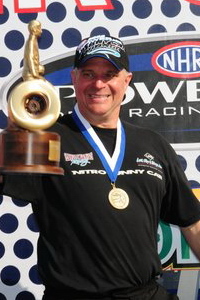THINGS ARE TOUGH ALL OVER
The combination of a sluggish economy and skyrocketing fuel prices
isn’t discriminating between the higher financed teams and those of
lesser means.

Is this just a passing season of financial tightness or have tough times set in for the long haul?
Bill Corwin of Sunoco Race Fuels says such a forecast is tough to determine.
“It’s hard to say because I was around in the 1970s,” said Corwin. “Everything was inflated, but if you were working your salary would go up to cover it. What we were used to paying isn’t as important. If you’re living on a fixed income then it becomes a larger issue.”
While Corwin is likely talking about the average consumer and not a race team, his point also hits home with those professional and sportsman race teams who negotiated sponsorships years ago based on 23-races with a greater economy. Some teams are forced to accept the higher operating costs on budgets forecasts prepared years ago.
The higher financed teams are cutting corners to combat increased expenses
The combination of a sluggish economy and skyrocketing fuel prices
isn’t discriminating between the higher financed teams and those of
lesser means.

Is this just a passing season of financial tightness or have tough times set in for the long haul?
Bill Corwin of Sunoco Race Fuels says such a forecast is tough to determine.
“It’s hard to say because I was around in the 1970s,” said Corwin. “Everything was inflated, but if you were working your salary would go up to cover it. What we were used to paying isn’t as important. If you’re living on a fixed income then it becomes a larger issue.”
While Corwin is likely talking about the average consumer and not a race team, his point also hits home with those professional and sportsman race teams who negotiated sponsorships years ago based on 23-races with a greater economy. Some teams are forced to accept the higher operating costs on budgets forecasts prepared years ago.
I’ve asked the employees for lists of how we can save money. We always verify that no one is in a room alone and that they’re sharing with someone. We’ve got to do that. The world’s not gonna get better. It will in time, we just have to make it a better place. If we want to make it better, we have to slow down, share a ride and do a lot of stuff. We’ve gotta handle it. We can’t count on the government. - John Force on cutting costs
John Force has four nitro teams plus finances sportsman racing
operations. He’s feeling the pinch of higher gas prices and the demand
for creative marketing plans to deliver for sponsors.
“Right now at John Force Racing we are in the toughest market that
we’ve ever been in,” admitted Force. “Ford and Castrol both have told
us that. We have to fight harder to protect our sponsorships. At the
end of the day, we’ve gotta learn how to save money.”
“We’re looking at everything – including nitro because the price has
gone crazy. We’re even turning off the [Ford] Excursions in the staging
lanes to save gas. If it ain’t too hot, we shut them down to save gas.
“We’re looking at the food we eat to the places we shop – even the
uniforms. We are looking to cut costs. You have to go back to the
basics.”

“We’re looking at everything on a business basis at this time,” Schumacher said. “What can we do to change the way we go down the road? What can we do to change vehicles out to not fly as many people in to reduce costs in all areas? Diesel costs -- what it costs. Do we need as many rigs on the road as we have on the road? What can we do to change our cost structure? What do we also have to do to pass some cost increases onto our sponsors to try and assist us in these areas? It’s a joint effort that we are going to have to look at, at this point.”
Force doesn’t want to return to the days when he raced out of poverty, but he does seek a return for the days of efficiency.
“I hear a lot of people and racers complaining they can’t live like this,” Force said. “Maybe they just came on in the last few years but I lived it thirty years ago. I want to go back. Don’t get me wrong, I don’t want to go back to poverty.
“Just like any machine that wins, parts break. The cost of labor and everything gets out of hand. Pretty soon you don’t know how you got here. I do. In the good times I share with my people. Now it’s hard times and I tell my people who want wage increases and I tell them if you don’t want me to lay anyone off, then shut those Excursions off. Show me you’ll roll the doors down in my shop and save the air conditioning when it’s 110 outside. Tell me that you’ll look through every part and piston. Don’t throw anything away because it’s too easy to buy something new. I have been drilling that and I’ve had meetings with the crew chiefs.
“I’ve asked the employees for lists of how we can save money. We always verify that no one is in a room alone and that they’re sharing with someone. We’ve got to do that. The world’s not gonna get better. It will in time, we just have to make it a better place. If we want to make it better, we have to slow down, share a ride and do a lot of stuff. We’ve gotta handle it. We can’t count on the government.”
The cost of nitromethane has doubled in the last three years and reportedly a new fuel tire is commanding upwards of $700 per slick. The sportsman side of the race gas increase has been reasonable but not the same as nitromethane. Such an increase isn’t the major issue in the big picture.
“The racer isn’t going to complain about the $8 per gallon for race gas, but he is going to look at the $5 per gallon of diesel,” Corwin said. “He’s looking at $300 for the duallie as opposed to $80 for race gas.
“The problem we’ve seen is the volume of racing gas is down because the racers just can’t afford to come to the races. The people who race are using just as much race gas as they used to. The price of the race gas just hasn’t gone up as much as the gas for the street.”

If a driver claims an 85 mile per hour speed is on a downhill grade,
the unit even records the grade of the road to report whether or not
the driver is telling the truth.
“With the rising cost of diesel fuel, more and more team owners are
wanting to keep track of every expense and right now, diesel is a
larger expense than ever,” Epler said. “I know it’s a bit of Big
Brother but this gives team owners an option they haven’t really had
before to track their expenses.”
In the last season, sources indicate the cost to field a nitro
operation for a multi-car team has increased over $250,000 per season
or more depending on the number of cars a team fields.
Force knows much of the blame is directed his way. He contends that his
plan for a multi-car operation was developed out of the desire to win
and by watching other forms of motorsports.
“You can’t blame technology and you can’t blame the multi-car teams,”
Force said. “I can say that I’ve worked my butt off to find money. I
was up in L.A. and New York pitching sponsorships. I’m in sponsor tents
working my butt off with drivers. I tell our drivers we need to work
more and not less.
“You can blame me. My growth came from trying to win. I saw it
[multi-car teams] in other forms of racing. We don’t want drag racing
to turn into another F-1 where only one team wins all the time. NHRA
saw it and leveled the playing field. With the Countdown to the
Championship, a team cannot win because they have more money than
anyone else to dominate like we could. The NHRA took care of that. It’s
going to be okay because we have a great product.”
Schumacher has six nitro teams, a Pro Stock Motorcycle as well as a
full hospitality program. Knowing the way the economy has affected him,
his heart goes out to the single-car and limited budget teams.
“I feel terrible for them,” Schumacher said. “I’ve always felt bad for
lower sponsored and lower financed teams. How they’re even able to do
it; just amazes me because I know I’m experiencing the cost increases
for all of the parts we utilize out here. It’s just tremendous.”

“I called my sponsor last week and I said ‘I can tell you right now I’m going to be 75,000 in the hole by the time I get home at the end of the year, if I keep running the way I’m running,” Wilkerson said. “If I wasn’t winning races, I’d be in trouble right now. It costs money to win rounds but at the same time as long as you are not hurting anything it’s okay. Knock on wood. We’ve had some pretty good weekends; haven’t hurt a thing. I haven’t lost a rod all year; we haven’t blown up our motor.”
Schumacher is quick to point out that the racing community shouldn’t expect a reprieve in the near future, either.
“Well this is a business,” Schumacher said. “You always have to look at ways to control your costs escalation and what the right thing to do is business-wise. It’s a tough business right now and it’s going to get tougher over the next year.”




































